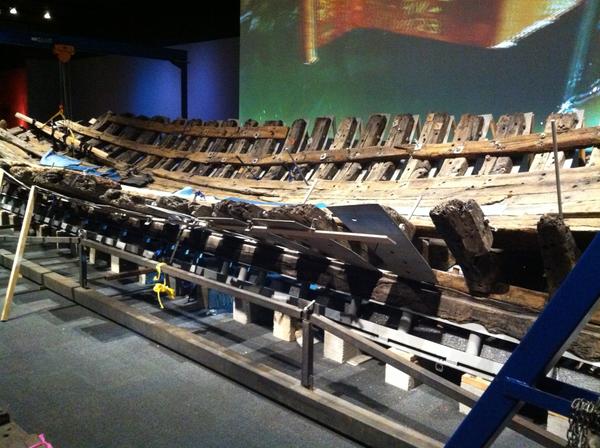At the Bullock Texas State History Museum in Austin, researchers have nearly finished piecing together a Texas mystery three centuries in the making. They’re rebuilding the La Belle, a ship that the French explorer La Salle wrecked along the Texas coast in 1685, ruining his chance of conquering Texas for France in the process.
Louis XIV, the Sun King, sent La Salle to find silver mines, but things didn’t much work out for the explorer, which is why visitors to the museum are now watching the La Belle being rebuilt from the bottom up.
“La Salle was a driven explorer … he was the first European to find the mouth of the Mississippi River, and to discover that it flowed into the Gulf of Mexico,” says Dr. Jim Bruseth. “And when [La Salle] did that, he claimed a third of North America for France, what later became the Louisiana Purchase, for the United States. He went back to France, presented that to King Louis IX, and got a commission to come back and to establish a colony at the mouth of the Mississippi River.”
Bruseth is curating this exhibit at the Bullock Museum of Texas History. As you walk into the museum’s hall, where ship’s bottom third is nearly intact now, you are, in effect, walking into the room that has been Bruseth’s office for the past eight months. He probably knows more about La Salle and his ship than just about anyone, and he says when La Salle returned to the Gulf, his expedition started going awry.
“La Salle came back and missed the Mississippi River by 400 miles and landed on the Central Texas coast, and thought he was at the mouth of the Mississippi River. Hard to believe, but he thought so.”
Where was he actually? “He was in Matagorda Bay and nowhere near the Mississippi River.”
But La Salle was convinced. And he spent a couple years wandering around, trying to find the Mississippi River.
He never did.Why was La Belle worth pulling up from the Gulf of Mexico mud? Because, Bruseth says La Belle was the final nail in the coffin. La Salle brought four ships: One was taken by pirates, another wrecked out in the Gulf of Mexico before it came into Matagorda Bay, a third ship sailed back to France. That means his last lifeline was the La Belle. “And so confident was he that the Mississippi River was near Matagorda Bay, on the Central Texas coast, that he loaded all the supplies he had left for his Mississippi Colony onto the La Belle, had it anchor in Matagorda Bay, while he would then go over land, find the Mississippi River, come back, and get La Belle.”
Fearing Native Americans on the coast, La Salle left 33 crew on board. “It’s a small vessel, 58 feet long, 15 feet wide, those people were crowded on that vessel, and he took off, said ‘I’ll be gone ten days.’ Well he was gone two months.”
Things got bad. The crew ran out of water, and a group that went ashore never came back, likely killed by Karankawa Native Americans.
But when the crew decided to pull up anchor and go around to the other side of Matagorda Bay, where other French colonists were, a storm blew in and the ship ran around in Matagorda Bay. And of the 33, only 7 people survived the wrecking of the La Belle.
The La Belle originally sank in shallow water. But then a second storm sank the La Belle into the mud. Without that, worms that were already decimating the wood may have eaten the whole ship. But the hull’s thick timbers were preserved and hidden, until the remains were uncovered in 1996. After the Texas Historical Commission and Bruseth dug it up, archaeologists sent the La Belle’s remains to Peter Fix at Texas A&M.
Fix is an archaeological conservator and nautical archeologist at the Conservation Research Laboratory at Texas A&M. Typically, conservators resuscitate oak that’s been submerged that long by slowly pumping the wood with polyethylene glycol, which is produced from oil. But they ran into a snag in 2008 – halfway through the process. “When oil was at $145 a barrel, it was going to be 4 times the cost, for the polyethylene glycol.” So the team invested in a very, very large vacuum freeze-drier, large enough to take in pieces of the ship – some longer than thirty feet – whole.
“The whole of our existence for the workday was just keeping up with the 1.6 million artifacts, or so, they continued to ship up to us,” Fix says.
And the artifacts are spectacular. There are canons, knives, iron tools, and jewels. “When I excavated La Belle, I found a chest that was about 3 foot long, a foot high, a foot wide, and when I opened it up, it was filled by hundreds of thousands of glass beads … strung by color,” Bruseth says.
Although the ship sank off Texas, the La Belle’s provenance is…tricky.
Who owns the La Belle? “The short answer is… we don’t,” Bruseth says. “When we finished excavating La Belle, in 1997, France claimed the ship.” In fact, it took an international treaty to keep the ship in Texas. But Bruseth says, it’s here to stay. The treaty says France and the United States must both agree to have the ship moved. And that, Bruseth says, is not going to happen.
La Salle, of course, didn’t outlast his ship for very long.
“La Salle came back, hadn’t found the Mississippi River and he realized his last ship, La Belle, was gone, and he decided that his only hope of getting supplies was to get 17 men with him and walk to Canada,” Bruseth says. “That’s the nearest place he could go where there were other French people who could give him supplies.” But that’s not all. “On the way, his men murdered him near Navasota, Texas.
The La Belle is being constructed live at the Bullock Museum, after which it takes a break for summer as they move it to the central atrium.















